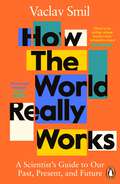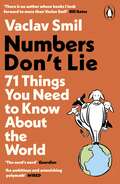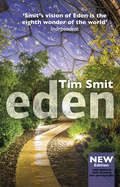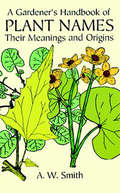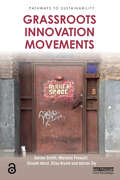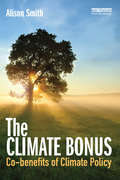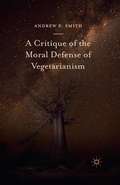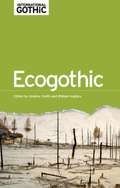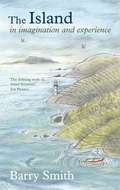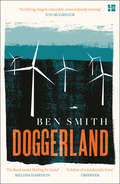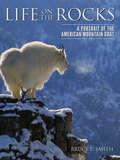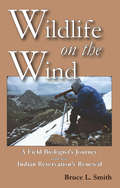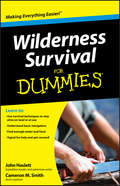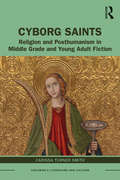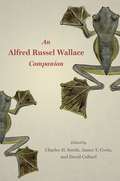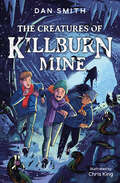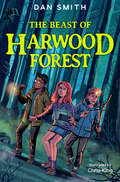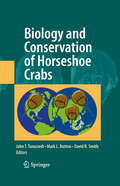- Table View
- List View
How the World Really Works: A Scientist’s Guide to Our Past, Present and Future
by Vaclav Smil* THE NEW YORK TIMES BESTSELLER * 'Another masterpiece from one of my favorite authors . . . If you want a brief but thorough education in numeric thinking about many of the fundamental forces that shape human life, this is the book to read. It's a tour de force' BILL GATES __________ We have never had so much information at our fingertips and yet most of us don't know how the world really works. This book explains seven of the most fundamental realities governing our survival and prosperity. From energy and food production, through our material world and its globalization, to risks, our environment and its future, How the World Really Works offers a much-needed reality check - because before we can tackle problems effectively, we must understand the facts. In this ambitious and thought-provoking book we see, for example, that globalization isn't inevitable and that our societies have been steadily increasing their dependence on fossil fuels, making their complete and rapid elimination unlikely. Drawing on the latest science and tackling sources of misinformation head on - from Yuval Noah Harari to Noam Chomsky - ultimately Smil answers the most profound question of our age: are we irrevocably doomed or is a brighter utopia ahead? __________ 'Very informative and eye-opening in many ways' HA-JOON CHANG, author of 23 Things They Don't Tell You About Capitalism 'If you are anxious about the future, and infuriated that we aren't doing enough about it, please read this book' PAUL COLLIER, author of The Future of Capitalism
Numbers Don't Lie: 71 Things You Need to Know About the World
by Vaclav Smil'There is no author whose books I look forward to more than Vaclav Smil' Bill GatesIs flying dangerous? How much do the world's cows weigh? And what makes people happy?From earth's nations and inhabitants, through the fuels and foods that energize them, to the transportation and inventions of our modern world - and how all of this affects the planet itself - in Numbers Don't Lie, Professor Vaclav Smil takes us on a fact-finding adventure, using surprising statistics and illuminating graphs to challenge lazy thinking.Packed with 'Well-I-never-knew-that' information and with fascinating and unusual examples throughout, we find out how many people it took to build the Great Pyramid, that vaccination yields the best return on investment, and why electric cars aren't as great as we think (yet). There's a wonderful mix of science, history and wit, all in bite-sized chapters on a broad range of topics.Urgent and essential, Numbers Don't Lie inspires readers to interrogate what they take to be true in these significant times. Smil is on a mission to make facts matter, because after all, numbers may not lie, but which truth do they convey?'He is rigorously numeric, using data to illuminate every topic he writes about. The word "polymath" was invented to describe people like him' Bill Gates 'Important' Mark Zuckerberg, on Energy 'One of the world's foremost thinkers on development history and a master of statistical analysis . . . The nerd's nerd' Guardian 'There is perhaps no other academic who paints pictures with numbers like Smil' Guardian 'In a world of specialized intellectuals, Smil is an ambitious and astonishing polymath who swings for fences . . . They're among the most data-heavy books you'll find, with a remarkable way of framing basic facts' Wired 'Vaclav Smil has led a 30-year career of interdisciplinary contrarianism, writing hundreds of scientific articles and dozens of books attacking sacred cows of Western environmental and geopolitical thought' Foreign Policy 'For a couple of decades, Vaclav Smil has been on my go-to list when questions arise about global trends and risks, and particularly about energy. He is a distinguished professor on the environment faculty at the University of Manitoba but really should be in the department of everything' Andrew Revkin, The New York Times 'One of the world's foremost experts on energy' Foreign Affairs 'An author who does not allow facts to be obscured or overshadowed by politics' New York Review of Books 'The man who has quietly shaped how the world thinks about energy' Science Magazine 'A radical thinker on energy and environmental issues' Financial Times 'He's a slayer of bullshit' David Keith, Gordon McKay Professor of Applied Physics & Professor of Public Policy, Harvard UniversityVaclav Smil is Distinguished Professor Emeritus at the University of Manitoba. He is the author of over forty books on topics including energy, environmental and population change, food production and nutrition, technical innovation, risk assessment and public policy. No other living scientist has had more books (on a wide variety of topics) reviewed in Nature. A Fellow of the Royal Society of Canada, in 2010 he was named by Foreign Policy as one of the Top 100 Global Thinkers. This is his first book for a more general readership.
Eden: Updated 15th Anniversary Edition
by Tim SmitUpdated, with stunning new photographs At the beginning of the twenty-first century, the impossible was delivered. From the sterile depths of a disused china clay pit in Cornwall rose one of the most remarkable and ambitious ventures in recent memory. The Eden Project’s Biomes, the world’s largest conservatories, are the symbol of a living theatre of plants and people and their interdependence, of regeneration and of a pioneering forum for the exploration of possible futures. This is the extraordinary story of the Eden Project, of its conception, design and construction, of the larger-than-life personalities who made it happen and of all that has happened since its doors were first opened to the public in 2001. It is now undisputedly one of the world’s great gardens with more than 17 million visitors flocking there and projects and partnerships all over the world.
A Gardener's Handbook of Plant Names: Their Meanings and Origins
by A. W. SmithFirst compact dictionary to combine definitions of botanical names in general usage with information on their derivation and guides to pronunciation. A monumental index provides a cross-reference from some 1,800 common plant names to corresponding botanical ones. Combines thoroughness, botanical rigor, and interesting facts and lore — all leavened with touches of humor.
Grassroots Innovation Movements (Pathways to Sustainability)
by Adrian Smith Mariano Fressoli Dinesh Abrol Elisa Arond Adrian ElyInnovation is increasingly invoked by policy elites and business leaders as vital for tackling global challenges like sustainable development. Often overlooked, however, is the fact that networks of community groups, activists, and researchers have been innovating grassroots solutions for social justice and environmental sustainability for decades. Unencumbered by disciplinary boundaries, policy silos, or institutional logics, these ‘grassroots innovation movements’ identify issues and questions neglected by formal science, technology and innovation organizations. Grassroots solutions arise in unconventional settings through unusual combinations of people, ideas and tools. This book examines six diverse grassroots innovation movements in India, South America and Europe, situating them in their particular dynamic historical contexts. Analysis explains why each movement frames innovation and development differently, resulting in a variety of strategies. The book explores the spaces where each of these movements have grown, or attempted to do so. It critically examines the pathways they have developed for grassroots innovation and the challenges and limitations confronting their approaches. With mounting pressure for social justice in an increasingly unequal world, policy makers are exploring how to foster more inclusive innovation. In this context grassroots experiences take on added significance. This book provides timely and relevant ideas, analysis and recommendations for activists, policy-makers, students and scholars interested in encounters between innovation, development and social movements.
Grassroots Innovation Movements (Pathways to Sustainability)
by Adrian Smith Mariano Fressoli Dinesh Abrol Elisa Arond Adrian ElyInnovation is increasingly invoked by policy elites and business leaders as vital for tackling global challenges like sustainable development. Often overlooked, however, is the fact that networks of community groups, activists, and researchers have been innovating grassroots solutions for social justice and environmental sustainability for decades. Unencumbered by disciplinary boundaries, policy silos, or institutional logics, these ‘grassroots innovation movements’ identify issues and questions neglected by formal science, technology and innovation organizations. Grassroots solutions arise in unconventional settings through unusual combinations of people, ideas and tools. This book examines six diverse grassroots innovation movements in India, South America and Europe, situating them in their particular dynamic historical contexts. Analysis explains why each movement frames innovation and development differently, resulting in a variety of strategies. The book explores the spaces where each of these movements have grown, or attempted to do so. It critically examines the pathways they have developed for grassroots innovation and the challenges and limitations confronting their approaches. With mounting pressure for social justice in an increasingly unequal world, policy makers are exploring how to foster more inclusive innovation. In this context grassroots experiences take on added significance. This book provides timely and relevant ideas, analysis and recommendations for activists, policy-makers, students and scholars interested in encounters between innovation, development and social movements.
The Climate Bonus: Co-benefits of Climate Policy
by Alison SmithWe urgently need to transform to a low carbon society, yet our progress is painfully slow, in part because there is widespread public concern that this will require sacrifice and high costs. But this need not be the case. Many carbon reduction policies provide a range of additional benefits, from reduced air pollution and increased energy security to financial savings and healthier lifestyles, that can offset the costs of climate action. This book maps out the links between low carbon policies and their co-benefits, and shows how low carbon policies can lead to cleaner air and water, conservation of forests, more sustainable agriculture, less waste, safer and more secure energy, cost savings for households and businesses and a stronger and more stable economy. The book discusses the ways in which joined-up policies can help to maximise the synergies and minimise the conflicts between climate policy and other aspects of sustainability. Through rigorous analysis of the facts, the author presents well-reasoned and evidenced recommendations for policy-makers and all those with an interest in making a healthier and happier society. This book shows us how, instead of being paralysed by the threat of climate change, we can use it as a stimulus to escape from our dependence on polluting fossil fuels, and make the transition to a cleaner, safer and more sustainable future.
The Climate Bonus: Co-benefits of Climate Policy
by Alison SmithWe urgently need to transform to a low carbon society, yet our progress is painfully slow, in part because there is widespread public concern that this will require sacrifice and high costs. But this need not be the case. Many carbon reduction policies provide a range of additional benefits, from reduced air pollution and increased energy security to financial savings and healthier lifestyles, that can offset the costs of climate action. This book maps out the links between low carbon policies and their co-benefits, and shows how low carbon policies can lead to cleaner air and water, conservation of forests, more sustainable agriculture, less waste, safer and more secure energy, cost savings for households and businesses and a stronger and more stable economy. The book discusses the ways in which joined-up policies can help to maximise the synergies and minimise the conflicts between climate policy and other aspects of sustainability. Through rigorous analysis of the facts, the author presents well-reasoned and evidenced recommendations for policy-makers and all those with an interest in making a healthier and happier society. This book shows us how, instead of being paralysed by the threat of climate change, we can use it as a stimulus to escape from our dependence on polluting fossil fuels, and make the transition to a cleaner, safer and more sustainable future.
A Critique of the Moral Defense of Vegetarianism
by Andrew F. SmithDrawing on research in plant science, systems ecology, environmental philosophy, and cultural anthropology, Andrew F. Smith shatters the distinction between vegetarianism and omnivorism. The book outlines the implications that these manufactured distinctions have for how we view food and ourselves as eaters.
EcoGothic (International Gothic Series)
by Andrew Smith William HughesThis book will provide the first study of how the Gothic engages with ecocritical ideas. Ecocriticism has frequently explored images of environmental catastrophe, the wilderness, the idea of home, constructions of 'nature', and images of the post-apocalypse – images which are also central to a certain type of Gothic literature. By exploring the relationship between the ecocritical aspects of the Gothic and the Gothic elements of the ecocritical, this book provides a new way of looking at both the Gothic and ecocriticism. Writers discussed include Ann Radcliffe, Mary Shelley, Ambrose Bierce, Algernon Blackwood, Margaret Atwood, Cormac McCarthy, Dan Simmons and Rana Dasgupta. The volume thus explores writing and film across various national contexts including Britain, America and Canada, as well as giving due consideration to how such issues might be discussed within a global context.
EcoGothic (International Gothic Series)
by Andrew Smith William HughesThis book will provide the first study of how the Gothic engages with ecocritical ideas. Ecocriticism has frequently explored images of environmental catastrophe, the wilderness, the idea of home, constructions of 'nature', and images of the post-apocalypse – images which are also central to a certain type of Gothic literature. By exploring the relationship between the ecocritical aspects of the Gothic and the Gothic elements of the ecocritical, this book provides a new way of looking at both the Gothic and ecocriticism. Writers discussed include Ann Radcliffe, Mary Shelley, Ambrose Bierce, Algernon Blackwood, Margaret Atwood, Cormac McCarthy, Dan Simmons and Rana Dasgupta. The volume thus explores writing and film across various national contexts including Britain, America and Canada, as well as giving due consideration to how such issues might be discussed within a global context.
The Island in Imagination and Experience: Antarctica And Subantarctic Islands 1959-2006
by Barry SmithFrom Treasure Island to Robben Island, from the paradise of Thomas More's 'Utopia' to Napoleon's purgatory on Elba, islands have proved irresistible to mankind's imagination since time immemorial. Self-confessed islomaniac Barry Smith explores how islands bewitch us so, and examines the kind of human experiences that islands inspire. Journeying all around the globe to take in the most fascinating stories of Earth's half a million islands, this book considers the unique geography, politics and economics of islands and their cultures. It traces their singular place in literature, religion and philosophy, and disentangles the myths and the facts to reveal just why islands exert such an insistent grip on the human psyche. 'Fascinating and wide-ranging.' Island Review 'A fascinating survey of the interplay between those little dots of land and the human imagination… Smith is excellent on the ways in which islands have always been pawns in geopolitical games…witty.' Geographical "Magisterial… A harrowing, enthralling piece of work that bears comparison with John Prebble's equally dense, equally passionate classic, The Highland Clearances … [A] fascinating, scrupulous, angry, scholarly book." Jim Perrin, The Great Outdoors
Doggerland
by Ben Smith‘The Road meets Waiting for Godot: powerful, unforgettable, unique’ Melissa Harrison, author of At Hawthorn Time. Doggerland is a superbly gripping debut novel about loneliness and hope, nature and survival – set on an off-shore windfarm in the not-so-distant future.
Life on the Rocks: A Portrait of the American Mountain Goat
by Bruce L. SmithThe American mountain goat is one of the most elusive and least familiar species of hoofed mammals in North America. Confined to the remote and rugged mountains of the western United States and Canada, these extraordinary mountaineers are seldom seen or encountered, even by those who patiently study them. Life on the Rocks offers an intimate portrayal of this remarkable animal through the eyes and lens of field biologist and photographer Bruce Smith. Color photographs and accounts of Smith's personal experiences living in Montana's Selway-Bitterroot Wilderness Area accompany descriptions of the American mountain goat's natural history. Smith explores their treacherous habitat, which spans the perilous cliffs and crags of the Rocky, Cascade, and Coast mountain ranges. The physical and behavioral adaptations of these alpine athletes enable them to survive a host of dangers, including six-month-long winters, scarce food sources, thunderous avalanches, social strife, and predators like wolves, bears, lions, wolverines, and eagles. Smith also details the challenges these animals face as their territory is threatened by expanding motorized access, industrial activities, and a warming climate. Life on the Rocks showcases the elegance and charm of this little-known creature, thriving in some of North America's harshest wilderness. Smith's volume will appeal to wildlife enthusiasts, wildland travelers, and conservationists interested in the future of the American mountain goat. 2014 National Outdoor Book Award winner: Nature & Environment and co-winner: Design and Artistic Merit
Wildlife on the Wind: A Field Biologist's Journey and an Indian Reservation's Renewal
by Bruce L. SmithIn the heart of Wyoming sprawls the ancient homeland of the Eastern Shoshone Indians, who were forced by the U.S. government to share a reservation in the Wind River basin and flanking mountain ranges with their historical enemy, the Northern Arapahos. Both tribes lost their sovereign, wide-ranging ways of life and economic dependence on decimated buffalo. Tribal members subsisted on increasingly depleted numbers of other big game—deer, elk, moose, pronghorn, and bighorn sheep. In 1978, the tribal councils petitioned the U.S. Fish and Wildlife Service to help them recover their wildlife heritage. Bruce Smith became the first wildlife biologist to work on the reservation. Wildlife on the Wind recounts how he helped Native Americans change the course of conservation for some of America's most charismatic wildlife.
Wilderness Survival For Dummies
by Cameron M. Smith John F. HaslettLearn to: Use survival techniques to stay alive on land or at sea Understand basic navigation Find enough water and food Signal for help and get rescued Your one-stop guide to surviving and enjoying the Great Outdoors Want to know how to stay alive in extreme situations? This practical, accurate guide gives you all the expert, field-tested tools and techniques you need to survive. Whether you find yourself lost in the woods, adrift on a life raft, bitten by a snake, or needing shelter in cold weather, this hands-on resource teaches you how to stay safe (and sane), find rescue, and live to tell the tale! Know the basics of survival — perform life-saving first aid, make fire and shelter, and find water and food Manage your emotions — cope with panic and anger, get the "survivor's attitude," and foster cooperation and hope with others Increase your chances of rescue — signal for help and navigate using a compass or the sky Practice expert survival methods — tie essential knots, craft your own weapons and tools, and make natural remedies Gain wisdom for water emergencies — stay afloat when your ship or boat sinks, avoid dehydration and starvation, and make it to shore Open the book and find: Common survival scenarios you may encounter Tried-and-tested advice for individuals or groups The items you need to stay alive Basic orientation skills Ways to keep warm or cool The best methods for building a fire in any environment What you can (and can't) eat and drink in the wild True stories of survival
Wilderness Survival For Dummies
by Cameron M. Smith John F. HaslettLearn to: Use survival techniques to stay alive on land or at sea Understand basic navigation Find enough water and food Signal for help and get rescued Your one-stop guide to surviving and enjoying the Great Outdoors Want to know how to stay alive in extreme situations? This practical, accurate guide gives you all the expert, field-tested tools and techniques you need to survive. Whether you find yourself lost in the woods, adrift on a life raft, bitten by a snake, or needing shelter in cold weather, this hands-on resource teaches you how to stay safe (and sane), find rescue, and live to tell the tale! Know the basics of survival — perform life-saving first aid, make fire and shelter, and find water and food Manage your emotions — cope with panic and anger, get the "survivor's attitude," and foster cooperation and hope with others Increase your chances of rescue — signal for help and navigate using a compass or the sky Practice expert survival methods — tie essential knots, craft your own weapons and tools, and make natural remedies Gain wisdom for water emergencies — stay afloat when your ship or boat sinks, avoid dehydration and starvation, and make it to shore Open the book and find: Common survival scenarios you may encounter Tried-and-tested advice for individuals or groups The items you need to stay alive Basic orientation skills Ways to keep warm or cool The best methods for building a fire in any environment What you can (and can't) eat and drink in the wild True stories of survival
Cyborg Saints: Religion and Posthumanism in Middle Grade and Young Adult Fiction (Children's Literature and Culture)
by Carissa Turner SmithSaints are currently undergoing a resurrection in middle grade and young adult fiction, as recent prominent novels by Socorro Acioli, Julie Berry, Adam Gidwitz, Rachel Hartman, Merrie Haskell, Gene Luen Yang, and others demonstrate. Cyborg Saints: Religion and Posthumanism in Middle Grade and Young Adult Fiction makes the radical claim that these holy medieval figures are actually the new cyborgs in that they dethrone the autonomous subject of humanist modernity. While young people navigate political and personal forces, as well as technologies, that threaten to fragment and thingify them, saints show that agency is still possible outside of the humanist construct of subjectivity. The saints of these neomedievalist novels, through living a life vulnerable to the other, attain a distributed agency that accomplishes miracles through bodies and places and things (relics, icons, pilgrimage sites, and ultimately the hagiographic text and its reader) spread across time. Cyborg Saints analyzes MG and YA fiction through the triple lens of posthumanism, neomedievalism, and postsecularism. Cyborg Saints charts new ground in joining religion and posthumanism to represent the creativity and diversity of young people’s fiction.
Cyborg Saints: Religion and Posthumanism in Middle Grade and Young Adult Fiction (Children's Literature and Culture)
by Carissa Turner SmithSaints are currently undergoing a resurrection in middle grade and young adult fiction, as recent prominent novels by Socorro Acioli, Julie Berry, Adam Gidwitz, Rachel Hartman, Merrie Haskell, Gene Luen Yang, and others demonstrate. Cyborg Saints: Religion and Posthumanism in Middle Grade and Young Adult Fiction makes the radical claim that these holy medieval figures are actually the new cyborgs in that they dethrone the autonomous subject of humanist modernity. While young people navigate political and personal forces, as well as technologies, that threaten to fragment and thingify them, saints show that agency is still possible outside of the humanist construct of subjectivity. The saints of these neomedievalist novels, through living a life vulnerable to the other, attain a distributed agency that accomplishes miracles through bodies and places and things (relics, icons, pilgrimage sites, and ultimately the hagiographic text and its reader) spread across time. Cyborg Saints analyzes MG and YA fiction through the triple lens of posthumanism, neomedievalism, and postsecularism. Cyborg Saints charts new ground in joining religion and posthumanism to represent the creativity and diversity of young people’s fiction.
An Alfred Russel Wallace Companion
by Charles Smith James A. Costa David CollardAlthough Alfred Russel Wallace (1823–1913) was one of the most famous scientists in the world at the time of his death at the age of ninety, today he is known to many as a kind of “almost-Darwin,” a secondary figure relegated to the footnotes of Darwin’s prodigious insights. But this diminution could hardly be less justified. Research into the life of this brilliant naturalist and social critic continues to produce new insights into his significance to history and his role in helping to shape modern thought. Wallace declared his eight years of exploration in southeast Asia to be “the central and controlling incident” of his life. As 2019 marks one hundred and fifty years since the publication of The Malay Archipelago, Wallace’s canonical work chronicling his epic voyage, this collaborative book gathers an interdisciplinary array of writers to celebrate Wallace’s remarkable life and diverse scholarly accomplishments. Wallace left school at the age of fourteen and was largely self-taught, a voracious curiosity and appetite for learning sustaining him throughout his long life. After years as a surveyor and builder, in 1848 he left Britain to become a professional natural history collector in the Amazon, where he spent four years. Then, in 1854, he departed for the Malay Archipelago. It was on this voyage that he constructed a theory of natural selection similar to the one Charles Darwin was developing, and the two copublished papers on the subject in 1858, some sixteen months before the release of Darwin’s On the Origin of Species. But as the contributors to the Companion show, this much-discussed parallel evolution in thought was only one epoch in an extraordinary intellectual life. When Wallace returned to Britain in 1862, he commenced a career of writing on a huge range of subjects extending from evolutionary studies and biogeography to spiritualism and socialism. An Alfred Russel Wallace Companion provides something of a necessary reexamination of the full breadth of Wallace’s thought—an attempt to describe not only the history and present state of our understanding of his work, but also its implications for the future.
An Alfred Russel Wallace Companion
by Charles H. Smith David CollardAlthough Alfred Russel Wallace (1823–1913) was one of the most famous scientists in the world at the time of his death at the age of ninety, today he is known to many as a kind of “almost-Darwin,” a secondary figure relegated to the footnotes of Darwin’s prodigious insights. But this diminution could hardly be less justified. Research into the life of this brilliant naturalist and social critic continues to produce new insights into his significance to history and his role in helping to shape modern thought. Wallace declared his eight years of exploration in southeast Asia to be “the central and controlling incident” of his life. As 2019 marks one hundred and fifty years since the publication of The Malay Archipelago, Wallace’s canonical work chronicling his epic voyage, this collaborative book gathers an interdisciplinary array of writers to celebrate Wallace’s remarkable life and diverse scholarly accomplishments. Wallace left school at the age of fourteen and was largely self-taught, a voracious curiosity and appetite for learning sustaining him throughout his long life. After years as a surveyor and builder, in 1848 he left Britain to become a professional natural history collector in the Amazon, where he spent four years. Then, in 1854, he departed for the Malay Archipelago. It was on this voyage that he constructed a theory of natural selection similar to the one Charles Darwin was developing, and the two copublished papers on the subject in 1858, some sixteen months before the release of Darwin’s On the Origin of Species. But as the contributors to the Companion show, this much-discussed parallel evolution in thought was only one epoch in an extraordinary intellectual life. When Wallace returned to Britain in 1862, he commenced a career of writing on a huge range of subjects extending from evolutionary studies and biogeography to spiritualism and socialism. An Alfred Russel Wallace Companion provides something of a necessary reexamination of the full breadth of Wallace’s thought—an attempt to describe not only the history and present state of our understanding of his work, but also its implications for the future.
An Alfred Russel Wallace Companion
by Charles H. Smith David CollardAlthough Alfred Russel Wallace (1823–1913) was one of the most famous scientists in the world at the time of his death at the age of ninety, today he is known to many as a kind of “almost-Darwin,” a secondary figure relegated to the footnotes of Darwin’s prodigious insights. But this diminution could hardly be less justified. Research into the life of this brilliant naturalist and social critic continues to produce new insights into his significance to history and his role in helping to shape modern thought. Wallace declared his eight years of exploration in southeast Asia to be “the central and controlling incident” of his life. As 2019 marks one hundred and fifty years since the publication of The Malay Archipelago, Wallace’s canonical work chronicling his epic voyage, this collaborative book gathers an interdisciplinary array of writers to celebrate Wallace’s remarkable life and diverse scholarly accomplishments. Wallace left school at the age of fourteen and was largely self-taught, a voracious curiosity and appetite for learning sustaining him throughout his long life. After years as a surveyor and builder, in 1848 he left Britain to become a professional natural history collector in the Amazon, where he spent four years. Then, in 1854, he departed for the Malay Archipelago. It was on this voyage that he constructed a theory of natural selection similar to the one Charles Darwin was developing, and the two copublished papers on the subject in 1858, some sixteen months before the release of Darwin’s On the Origin of Species. But as the contributors to the Companion show, this much-discussed parallel evolution in thought was only one epoch in an extraordinary intellectual life. When Wallace returned to Britain in 1862, he commenced a career of writing on a huge range of subjects extending from evolutionary studies and biogeography to spiritualism and socialism. An Alfred Russel Wallace Companion provides something of a necessary reexamination of the full breadth of Wallace’s thought—an attempt to describe not only the history and present state of our understanding of his work, but also its implications for the future.
The Crooked Oak Mysteries (The Crooked Oak Mysteries #5)
by Dan SmithA meteorite harbouring an alien lifeform crashes to Earth with horrifying consequences in this gruesome and gripping tale from master of creepy sci-fi Dan Smith.
The Crooked Oak Mysteries (The Crooked Oak Mysteries #2)
by Dan SmithPete, Nancy and Krish's school camping trip takes a turn for the sinister when they uncover a terrifying mystery … A page-turning thriller for fans of the supernatural from bestselling author Dan Smith.
Biology and Conservation of Horseshoe Crabs
by David Smith Mark L. Botton John T. TanacrediHorseshoe crabs, those mysterious ancient mariners, lured me into the sea as a child along the beaches of New Jersey. Drawn to their shiny domed shells and spiked tails, I could not resist picking them up, turning them over and watching the wondrous mechanical movement of their glistening legs, articulating with one another as smoothly as the inner working of a clock. What was it like to be a horseshoe crab, I wondered? What did they eat? Did they always move around together? Why were some so large and others much smaller? How old were they, anyway? What must it feel like to live underwater? What else was out there, down there, in the cool, green depths that gave rise to such intriguing creatures? The only way to find out, I reasoned, would be to go into the ocean and see for myself, and so I did, and more than 60 years later, I still do.
